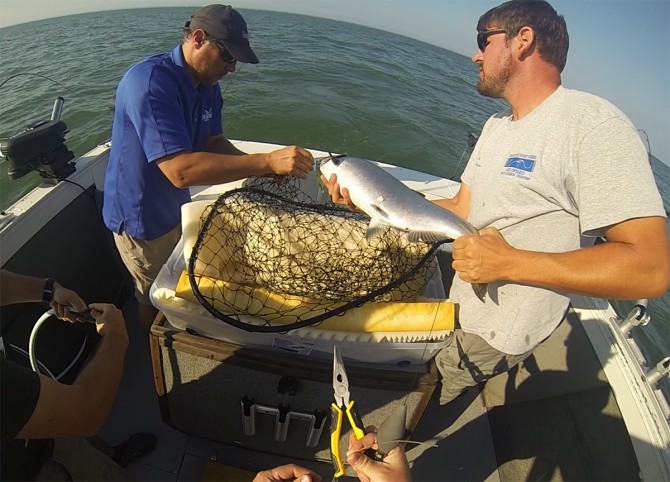With satellite tags, researchers track, protect Lake Ontario king salmon
By Jennifer Savran Kelly
King salmon have been making a royal splash in New York state’s economy for decades, generating millions of dollars annually from anglers and for communities around Lake Ontario. The salmon population in Lake Ontario has been thriving, yet across much of the Great Lakes, these valuable fish, also known as Chinook salmon, are in decline.
To better understand and protect the species and the economic benefits they generate, Cornell researchers, in collaboration with New York Sea Grant, are using newly developed “pop-off” satellite tags attached to the fish to map their movements and feeding behavior in Lake Ontario.
When these advanced tags sense a lack of vertical motion, they release off the fish and transmit data to a satellite after a preprogrammed period – 30, 60 and 90 days. The research is providing an unprecedented glimpse into the life of king salmon, allowing Cornell researchers to understand the behavior and movement of adult king salmon with more precision than ever possible before.
James Watkins, research associate in the Department of Natural Resources and principal investigator of the project funded by New York Sea Grant said, “This species is key for the ecosystem as a top predator and also as an economic engine for coastal communities where salmon fishing in the open lake and tributaries is big business. This work is helping to protect the fish and the thousands of people across the Great Lakes region who rely on them for their livelihood.”
Of all the Great Lakes, Lake Ontario boasts the most and biggest king salmon, which can reach lengths of more than 3 feet and weigh more than 30 pounds. The salmon forage almost exclusively on alewife, a small species of herring that dominates the catches in state and federal surveys.
King salmon are native to the Pacific coast. They were introduced to Lake Ontario in 1969 to control populations of alewife. Alewife populations grew in the absence of native predators like Atlantic salmon and lake trout, which suffered from overfishing and other pressures. This resulted in declines in water clarity because alewife consume zooplankton that would have kept blooming phytoplankton in check. Alewife are also known to experience significant die-offs that fouled beaches. King salmon were introduced to control alewife and modify Lake Ontario as a recreation destination, according to Jesse Lepak, Great Lakes fisheries and ecosystem health specialist for New York Sea Grant.
“The salmon fishery developed from a management action to control alewife populations,” Lepak said. “Few people at the time might have expected it to turn into the multimillion dollar fishery it is today.”
During the summer, salmon will typically feed at depths of 50 feet or deeper in search of prey fish in cool water (45-50 degrees). Salmon also move to deeper water at certain times of the day, but little is known about exactly when or why they do this.
Previous, less sophisticated tagging studies indicated that king salmon disperse widely across the lake. The new tags will allow Watkins and his team to map day and night vertical excursions, as well as use light data and temperature profiles to estimate paths across the lake. The tags also contain accelerometers that will provide valuable behavioral information about when the salmon are moving quickly while feeding.
The study is already showing results. A tag placed on a mature salmon July 13 in waters near Oswego was releases Aug. 31 on the opposite side of the lake near Cobourg, Ontario, 90 miles away. The fish entered Cobourg Creek, a shallow, coldwater tributary, probably to spawn.
Recovered by researchers Sept. 6, the tag provided researchers 49 days’ worth of data, with unprecedented information about the depth, location and acceleration of the fish at one-second intervals throughout its voyage.
Deployed in July, the first tags are set to deliver data in September and October. Watkins said their next deployment may span the full year of 2018.
Jennifer Savran Kelly is a writer for the College of Agriculture and Life Sciences.
Media Contact
Get Cornell news delivered right to your inbox.
Subscribe